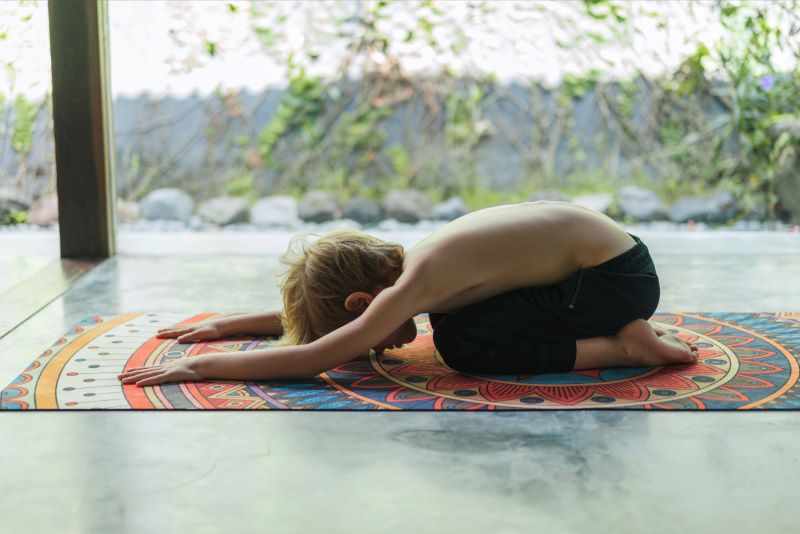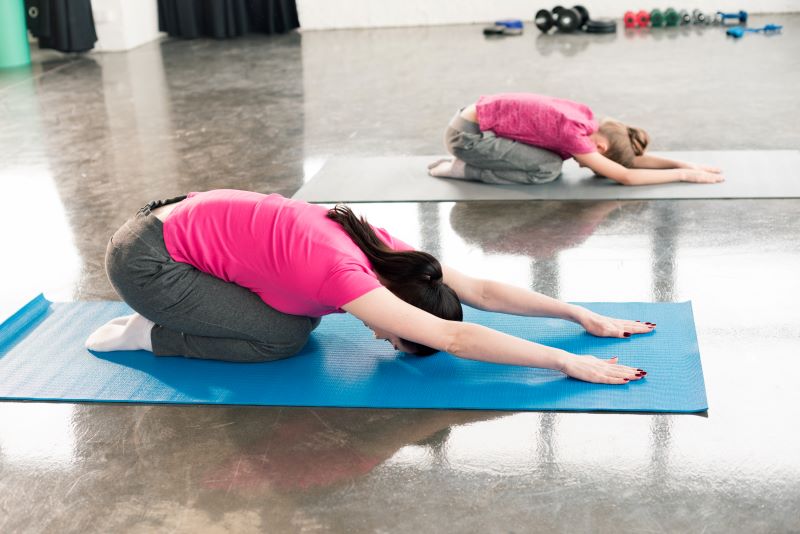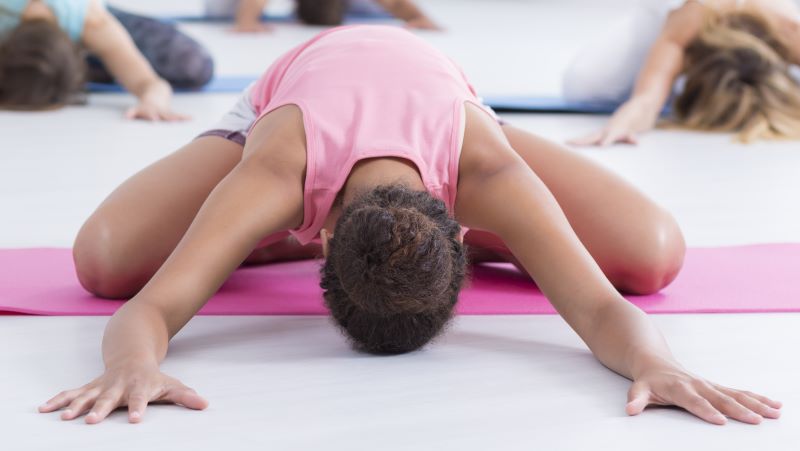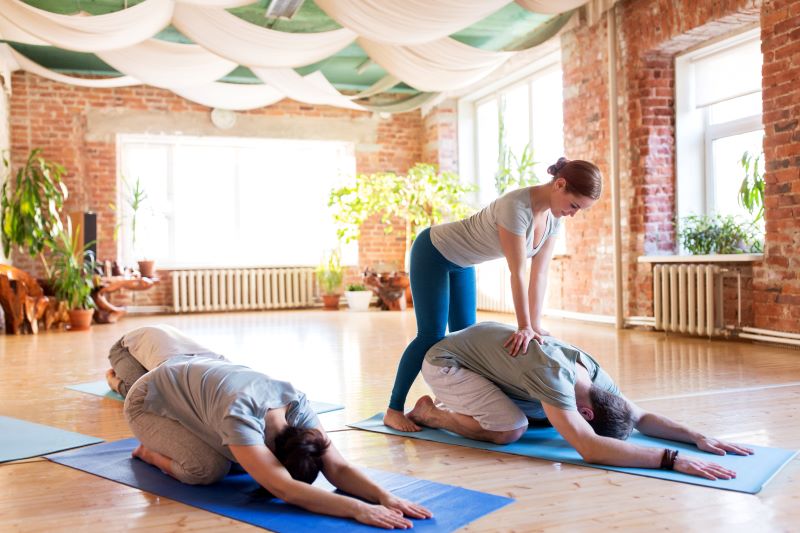18 Health Benefits of Balasana & How to Do It?

Balasana, or the Child's Pose, is a yogasana that not only helps to relieve stress and anxiety levels but also relieves back pain as it stretches your back. Read on to know the benefits of Balasana and how to perform it correctly.

Table of Contents

What is Balasana?
Child’s Pose or Balasana is a simple yoga asana perfect for both beginner and expert practitioners. It is an effective way to stretch your hips, thighs, ankles, and back. This resting posture allows you to reconnect with your soul.
In Sanskrit, ‘Bala’ means ‘child’, and ‘Asana’ means 'posture/exercise'. This asana involves facing the floor in the form of a child, so it is named Child's Pose. It is a counter exercise for many other exercises, as it helps slow down your breathing after rigorous activity. Also known as Shashankasana or Garbhasana, there are several advantages to doing Balasana. Let us find the top benefits of doing Child’s Pose.
How to Perform Balasana (Child Pose)?

Step 1: Come down to your knees and put your hands on a yoga mat.
Step 2: Now, spread your knees wider while keeping the tops of your feet and the big toes touching the floor.
Step 3: Then, allow your belly to rest between your thighs. Slowly bend your forehead to the floor. Now, relax, calm down, and let your shoulders, jawline and eyes release stress.
Step 4: Stretch your arms before you, moving the palms to the floor. You can also bring your arms to the backside, facing the palms upwards.
Step 5: Inhale, exhale evenly, and reconnect with your soul by focusing on breathing.
Step 6: Remain in this posture for 5 minutes and then return to sitting. Now, slowly open your eyes.
Step 7: Rub your palms and place them on your eyes and face to feel the warmth.
18 Health Benefits of Balasana
Child’s Pose is easy to follow and is a highly beneficial yoga posture that boosts flexibility and enhances muscle strength. Additionally, it tones your body and improves your breathing. Here are the top 18 health benefits of Child’s Pose:
1. Relaxes Your Mind
A stressed-out mind affects the body, resulting in an unhealthy lifestyle. To prevent yourself from such instances, do the Child’s Pose yogasana regularly. You will feel an instant soothing experience after you rest your forehead slowly on the floor while doing this exercise. As you close your eyes, your brain signals to the central nervous system. This relaxes your mind, promotes safety, and reduces anxiety levels.
2. Boosts Digestion
Regularly practising this yoga posture will improve your digestive system. As you rest the stomach on the top of your thighs, it massages the abdominal organs and allows movement of the digestive system. During the posture, ensure deep inhales and exhales in gentle and repetitive rhythms. As you do it repetitively, it will strengthen your intestinal tract and reduce the risk of acidity.
3. Stretches Lower Back
If your job involves constant standing or sitting, it might lead to compression in your lower back, causing severe back aches. This is because we tend to put all our body weight on the lower body part and do not involve the lower abdominal muscles in activities for days. During this asana, stretching your body widens your lower back area, allowing your body to strengthen and lengthen.
4. Opens up Your Hips
As you sit for prolonged hours due to work pressure, the muscles around your hips tend to tighten, thus causing discomfort. In Child's Pose, as you widen the knees and allow your stomach to rest in between the knees, your hips get stretched. This posture reduces hip pain, maintaining the health of your hip muscles.
5. Stimulates Blood Circulation
One of the many benefits of Balasana is that it stimulates blood circulation if you regularly practise this yogasana. Increased blood circulation allows optimal functioning of the abdominal organs, boosting the overall health of your body.
6. Strengthens Ligaments
Healthy ligaments help to stabilise your joints and promote bone health. If you lack strong ligaments, it might lead to several health issues. Practising Balasana regularly strengthens and stretches the ligaments and the tendons of the knees, thus helping you to perform daily activities smoothly.
7. Stretches Shoulders and Ankles
Child's Pose stretches your ankles and shoulders, allowing improvement in body movement. As you stretch your upper body part while doing this yogasana, it increases mobility and boosts your body’s balance. Additionally, it allows flexibility, thus preventing any injury to the shoulders and ankles.
8. Reduces Physical Tiredness
Child's Pose is a simple yet powerful therapeutic exercise that eases physical tension and encourages calm. The body's position and the mild stretch release tension and exhaustion, leaving you refreshed.
9. Battles Insomnia
It is a calming, restorative yoga pose that helps you fight insomnia by releasing tension from your body and encouraging sound sleep. Frequent practice can enhance sleep quality and help control sleep patterns.
10. Increases Energy Levels
Regularly strengthening your muscles with Child's Pose makes your body more energised. By lowering fatigue and raising general stamina, the pose revitalises the body. It lowers the stress hormones, allowing your body to conserve energy.
11. Opens Chest Muscles
As it opens up the chest muscles and strengthens the respiratory system, the pose of balance releases tension from the chest. This enhances lung expansion and breathing effectiveness. This position improves oxygen intake by stretching the surrounding muscles.
12. Stretches the Spine
Your spine stretches into Child's Pose as you bend over and pull on your lower back. This stretch helps relieve back pain, straighten the spine, and enhance posture. This pose's mild traction helps to decompress the vertebrae, which lessens the pressure on the spinal discs.
13. Reduces Constipation Risk
Because this posture involves massaging the abdominal organs, it lowers the risk of constipation. The mild abdominal pressure aids in enhancing digestion and promoting bowel motions.
14. Eases Restless Leg Syndrome
Balasana aids in the prevention of restless leg syndrome, which is brought on by excessive restlessness or anxiety. The pose aids in reducing the symptoms of this condition and calming the nerves.
15. Promotes Healthy Eating Habits
This pose strengthens your digestive system and encourages eating a healthy diet. Frequent exercise can improve digestion and metabolism, promoting a balanced diet. Balasana aids in the digestion and absorption of nutrients, maintaining a healthy digestive tract, and being a vital component of general health and wellbeing.
16. Boosts Relaxation
Child’s Pose is a powerful tool for mental relaxation. By focusing on deep breathing and gentle stretching, this pose helps reduce stress and promote a sense of inner peace. Lowering the forehead to the ground and closing the eyes induces a calming effect on the brain.
17. Enhances Concentration
Regular practice of Balasana can improve concentration and mental clarity. The pose's meditative aspect helps focus the mind and improve overall cognitive function. By providing a break from the constant stream of thoughts, this pose allows for mental stillness and heightened awareness.
18. Balances Emotions
Balasana helps to maintain emotional well-being by encouraging calmness and lowering stress. This pose helps you feel more grounded and at ease by releasing pent-up emotional tension. Child's Pose promotes emotional stability and resilience by having a grounding effect.
The Mudras of Balasana (Child Pose)
Mudras, or hand gestures, play a significant role in enhancing the effectiveness of yoga postures, including Balasana. Incorporating specific mudras into your Child’s Pose practice can amplify this pose’s physical and mental benefits. Here are some mudras that can be integrated with Balasana:
1. Anjali Mudra
In the Anjali Mudra or Prayer Position, the palms are pressed together in front of the heart. While in Balasana, bring your palms together above your head, pressing firmly. This gesture enhances the spiritual and meditative aspects of Balasana by fostering a sense of gratitude and reverence.
Benefits of Anjali Mudra: This mudra enhances feelings of peace and gratitude. It also helps centre the mind and body, promoting a sense of inner harmony and balance.
2. Adi Mudra
Fold your thumb into your palm and curl your other fingers over it to create Adi Mudra in Balasana. Rest your hands palms down on your thighs while seated in this relaxing pose. Adi Mudra deepens the meditative experience in Balasana, increases relaxation, and encourages concentration.
Benefits of Adi Mudra: This mudra helps expand lung capacity, promoting deeper and more efficient breathing. It activates the parasympathetic nervous system, helping to calm the mind and reduce stress.
Types of Balasana
By exploring different types of Balasana, you can target specific areas of the body and enhance your overall yoga practice. Here are five variations of Balasana, each with unique benefits and applications.
1. Extended Child's Pose (Utthita Balasana)

In this variation, the arms are stretched forward, extending the spine further and providing a deeper stretch for the back and shoulders. This version helps to enhance flexibility and release tension in the upper body.
2. Wide-Knee Child's Pose (Prasarita Balasana)

This pose involves spreading the knees wide apart while keeping the big toes touching. It creates a deeper stretch in the hips and groin area, making it particularly beneficial for those with tight hips.
3. Side Child's Pose (Parsva Balasana)
In this variation, you stretch one arm to the side while keeping the other arm extended forward. This modification provides a lateral stretch to the torso and helps improve flexibility in the sides of the body.
4. Restorative Child's Pose (Balasana with Bolster)
Using a bolster or pillow under the torso, this variation offers a more restorative experience. It supports the body, allowing for deeper relaxation and reducing strain on the back and knees.
5. Reclined Child's Pose (Supta Balasana)
In this pose, you lie back with your knees drawn towards your chest, mimicking the Child's Pose while on your back. This variation is gentle on the joints and provides a soothing stretch for the lower back and hips.
Things to Know Before Doing Balasana Yoga
Before practising Balasana, also known as Child’s Pose, it is essential to understand its proper technique and the precautions necessary to avoid injury. This resting pose benefits beginners and experienced practitioners, offering deep relaxation and stretching.
- Perform on an Empty Stomach: To prevent discomfort and encourage better digestion, perform Balasana at least 4-6 hours after eating.
- Warm-Up Properly: Engage in light warm-up exercises to prepare your body, especially your hips, back, and knees, to reduce the risk of strain.
- Use a Yoga Mat: A non-slip yoga mat provides necessary support and comfort, helping maintain proper posture during the pose.
- Avoid if Injured: Refrain from practising if you have knee, back, or shoulder injuries, as it may exacerbate the condition.
- Pregnancy Precaution: Pregnant women should avoid or modify this pose unless supervised by a trained yoga instructor.
- Breath Control: Maintain steady, deep breathing throughout the pose to enhance muscle relaxation and oxygen flow.
How Long to Sit in Balasana?
The duration you should hold Balasana or Child's Pose depends on your experience level and comfort. It's essential to listen to your body and progress gradually to avoid strain and injury.
- Beginners: If you are new to Balasana, start by holding the pose for just a few minutes. Aim for 1 to 5 minutes initially, focusing on proper form and steady breathing.
- Intermediate Practitioners: As you become more comfortable with the pose, you can extend your practice to 5 to 10 minutes. This allows for more profound relaxation and stretching, helping to build strength and flexibility.
- Advanced Practitioners: Experienced yogis may hold Balasana for up to 15 minutes or longer. This extended duration enables enhanced relaxation, meditation, and physical benefits.
Remember, it's crucial to progress at your own pace and not push yourself beyond your limits. If you feel discomfort or strain, gently release the pose and rest. Always honour your body and its needs during your yoga practice.
Risks of Overdoing Balasana
While Balasana, or Child's Pose, offers numerous benefits, overdoing it can lead to potential risks and discomfort. Moderation and listening to your body's signals are crucial to avoid strain and injury.
- Potential for Strain: Holding Balasana for too long or forcing the body into deep stretches can lead to muscle strain, particularly in the knees, hips, and lower back.
- Compression of Joints: Excessive pressure on the knees and ankles in Balasana can compress the joints, leading to discomfort and potential injury over time.
- Aggravation of Existing Injuries: Overdoing Balasana can exacerbate knee, hip, or back injuries, causing increased pain and discomfort.
- Limited Blood Flow: Prolonged periods in Balasana can restrict blood flow to the legs and feet, potentially leading to numbness or tingling sensations.
- Impact on Breathing: Holding the pose for too long may affect standard breathing patterns, leading to shallow breathing or discomfort in the chest.
Important Tips for Practising Balasana
While Balasana appears simple, mastering it can pose challenges, especially for beginners. However, these tips will aid you in performing the pose seamlessly:
- Start with Modified Poses: Begin with variations like Wide-Knee Balasana to acclimate to the leg position gradually.
- Progress Gradually: Initially, limit your practice duration, gradually increasing it as you become more proficient.
- Focus on Breathing: Take slow, deep breaths to foster relaxation and mental clarity during the pose.
- Practice Timing: Incorporate Balasana into your morning and bedtime routines for improved sleep quality and a refreshed start to the day.
- Avoid Overexertion: Try not to strain or injure your muscles and joints by shoving your legs into an awkward position.
- Maintain stability in your Ankles: Avoid rolling them inward, which can strain your joints and cause pain.
- Push Yourself: Experiment with different variations to intensify the pose, such as raising your body a little off the ground with your hands for support.
What are the Precautions and Contraindications of Balasana?
Keep in mind the precautions and the contraindications to avoid any injury during the yoga asana:
If you suffer from a neck, back, or shoulder injury, it is not ideal to practise this asana.
Avoid performing Child’s Pose if you suffer from severe knee and joint pains or injuries.
Wear comfortable sports clothes during the yogasana to ensure easy stretching.
Until an experienced trainer guides or permits you, you must not perform Child's Pose if you are pregnant.
Try to do some warm-up exercises before practising this yogasana. This will calm down your mind.
It is ideal to perform Balasana in the early hours of the morning on an empty stomach. Therefore, avoid consuming heavy meals before doing this exercise.
If you have had any back, knee, or leg surgery, consult your doctor before attempting this exercise.
Empty your bowel before performing this yogasana to ensure comfort.
Who Should Avoid Doing Balasana?
While Balasana offers numerous benefits, specific individuals should exercise caution or avoid it altogether to prevent discomfort or injury:
- Knee or Hip Injuries: Those with knee or hip injuries should be cautious as Balasana involves bending the knees and placing pressure on the joints.
- Ankle Issues: Individuals with ankle problems or recent ankle injuries should avoid Balasana, which requires flexing the ankles and may exacerbate discomfort.
- Pregnancy: Pregnant women, especially in the later stages of pregnancy, should avoid Balasana due to the pressure it places on the abdomen. Modified versions may be more suitable under the guidance of a qualified instructor.
- Digestive Issues: Those experiencing severe digestive issues such as hernias or digestive tract disorders should avoid Balasana, as the pose may exacerbate discomfort or pressure in the abdominal area.
- High Blood Pressure: Individuals with uncontrolled high blood pressure should approach Balasana cautiously, as the forward bend may temporarily increase blood pressure.
- Recent Surgery: Individuals who have undergone recent surgery, particularly abdominal or pelvic surgery, should avoid Balasana until they fully recover and receive clearance from their healthcare provider.
- Vertigo or Dizziness: Those prone to vertigo or dizziness may find Balasana exacerbates these symptoms, particularly if the head is positioned below the heart for an extended period.
What are the Easy Modifications of Balasana?

Although it is easy for beginners to perform this exercise, in case you feel any discomfort, you can come up with variations of Child's Pose. Here they are:
While doing the posture, you can stretch your arms forward, facing the palms upwards. Then, you can try to bend the elbows to allow the palms to touch and place the thumbs at the backside of the neck.
Additionally, you can keep your knees closer instead of keeping them wide.
You can also tuck your toes under if you feel pain while keeping your feet flat on the ground.
To take the extra stress off your shins, roll a towel underneath.
Use a couple of bolsters, pillows, or cushions to support your weight underneath the stomach and chest.
Now that you understand Balasana and its benefits, you must regularly practice it to ensure a healthy body posture. This yogasana is perfect for relieving stress and calming your body and mind.














